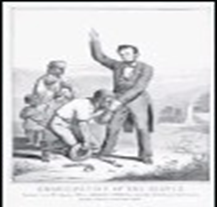Beginning of the end of Slavery

As European settlers laid claim to the New World, they brought with them the practice of slavery. Slave traders would sail to Africa and capture Africans from their tribes, shackle them in chains, and bring them to America on ships. They were then sold in America to provide free labor on farms and plantations.
Slaves were considered the property of their owners and endured brutal, inhumane treatment. The lucrative transatlantic slave trade and enslavement of Africans in America continued for two centuries, as generations of people were born into bondage and died as slaves.
By the middle of the 1800s, however, slavery had become a very divisive issue in the United States. Northern states were moving to abolish slavery, and the country had elected a President, Abraham Lincoln, who opposed slavery.
The southern states saw the growing anti-slavery movement and the election of Abraham Lincoln as a threat to their way of life and economic survival. Tensions between the south and the Federal government had been building over a long time, and now slavery was just one more issue dividing north from south, and alienating southern states from the federal government.
Within a few months of Lincoln being elected president, 11 southern states had seceded (broken away) from the United States, declaring themselves a separate confederacy of independent states. In the summer of 1861, war between the southern Confederacy and the northern Union broke out. The American Civil War had begun.
On September 22, 1862, the United States was into its second year of the Civil War when President Lincoln issued an ultimatum to rebel states: Rejoin the Union by January 1, 1863 or the slaves in those states would be freed.
The decree included an offer for the government to compensate slave owners in exchange for freeing their slaves.
The Confederate states turned down the offer, but the decree had set in motion President Lincolns movement toward using the power of the presidency to end slavery.
On January 1, 1863, Lincoln issued an executive order known as the Emancipation Proclamation. It freed the slaves in the rebel, or Confederate states and allowed for freed slaves to join the Union Army.
Nearly 200,000 blacks and former slaves fought for the north, providing a troop reinforcement that was vital an illustration depicts Abraham Lincoln demanding emancipation of slaves in 1862, for the Unions victory in 1865.
The Emancipation Proclamation did not free the slaves in the southern slave states that had remained loyal to the Union, nor did it order the freeing of slaves in the north. Its threat of freeing the slaves in rebel states was intended to compel those states to return to the Union.
President Lincoln and his advisers were aware of, and lamented, the irony of the decree, but President Lincoln did not want to penalize slave states which had stayed loyal to the Union at that time.
Yet, despite the limits of the Emancipation Proclamation, it officially linked the civil War to the moral issue of abolishing slavery dramatically changed the way Americans thought about slavery and ended one of the darkest and most shameful periods of Americas history.

